Analyzing Apple’s A8 SoC: PowerVR GX6450 & More
by Ryan Smith on September 10, 2014 5:00 AM EST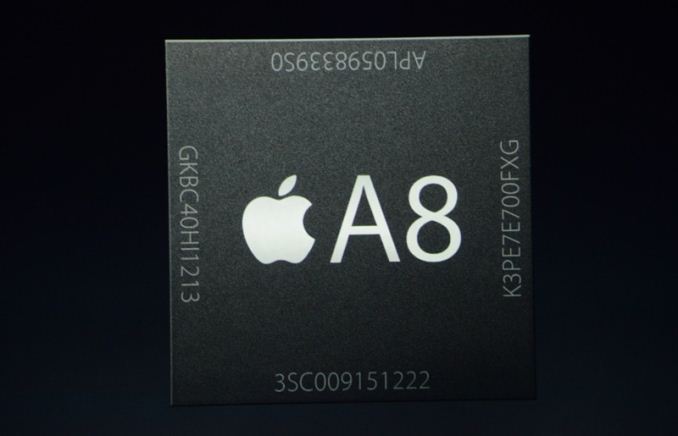
With their iPhone keynote behind them, Apple has begun updating some of their developer documentation for iOS to account for the new phone. This of course is always a fun time for tech punditry, as those updates will often include information on the hardware differences in the platform, and explain to developers the various features that different generations of hardware can offer developers.
To that end we have compiled a short analysis of the A8 SoC based on these documents and other sources. And we believe that at this point we have a solid idea of the configuration of Apple's latest SoC.
| Apple SoC Specifications | ||||||
| Apple A6 | Apple A7 | Apple A8 | ||||
| CPU | Swift @ 1.3GHz(x2) | Cyclone @ 1.3GHz (x2) | Enhanced Cyclone @ 1.4GHz (x2)? | |||
| GPU | PVR SGX543MP3 | PVR G6430 | PVR GX6650 | |||
| RAM | 1GB LPDDR2 | 1GB LPDDR3 | 1GB LPDDR3? | |||
A8’s GPU: Imagination PowerVR Series6XT GX6650 GX6450
On the GPU front this year appears to be especially bountiful. After being tipped to an update for Apple’s Metal Programming Guide, we can now infer with near certainty that we know what the A8 GPU is.
New to this edition of the Metal Programming Guide is a so-called iOS_GPUFamily2, which joins the existing iOS_GPUFamily1. We already know that the iOS_GPUFamily1 is based around Imagination’s PowerVR Series 6 G6430 GPU, so the real question is what does iOS_GPUFamily2 do that requires a separate family? The answer as it turns out is ASTC, the next generation texture compression format is being adopted by GPU vendors over the next year or so.
Imagination’s PowerVR Series6 family of GPUs predates ASTC and as a result iOS_GPUFamily1 does not support it. However we know that Imagination added support for it in their Series6XT designs, which were announced at CES 2014. Coupled with the fact that Apple’s documentation supports the idea that all of their GPUs are still TDBR (and thus PowerVR), this means that the GPU in the A8 must be a Series6XT GPU in order for ASTC support to be present.
This leaves the question of which of Imagination’s 4 Series6XT Apple is using. Imagination offers a pair of 2 core designs, a 4 core design (GX6450), and a 6 core design (GX6650). Considering that Apple was already using a 4 core design in A7, we can safely rule out the 2 core designs. That leaves us with GX6450 and GX6650, and to further select between those options we turn to Apple’s A8 performance estimates.
| Apple SoC Evolution | |||||
| CPU Perf | GPU Perf | Die Size | Transistors | Process | |
| A5 | ~13x | ~20x | 122m2 | <1B | 45nm |
| A6 | ~26x | ~34x | 97mm2 | <1B | 32nm |
| A7 | 40x | 56x | 102mm2 | >1B | 28nm |
| A8 | 50x | 84x | 89mm2 | ~2B | 20nm |
A8 is said to offer 84x the GPU performance of the iPhone 1, while last year Apple stated that the A7 offered 56x the iPhone 1’s performance. As a result we can accurately infer that the A8 must be 1.5x faster than the A7, a nice round number that makes it easier to determine with GPU Apple is using. Given Apple’s conservative stance on clockspeeds for power purposes and the die space gains from the 20nm process, accounting for a 50% performance upgrade is easily done by replacing a 4 core G6430 with the 6 core GX6650. At equal clockspeeds the GX6650 should be 50% faster on paper (matching Apple’s paper numbers), leading us to strongly believe that the A8 is utilizing a PowerVR Series6XT GX6650 GPU.
Once the iPhone 6 is out and Chipworks can photograph the SoC, this should be easy to confirm. If Apple is using a GX6650 then the die size of the GPU portion of the A8 should be very similar to the die size of the GPU portion of the A7. Otherwise if it is the 4 core GX6450, then Apple should see significant die size savings from using a 20nm fabrication process.
Update: The Chipworks die shots have confirmed that there are only 4 GPU cores present, not 6. So our earlier speculation was wrong; A8 is powered by GX6450, not GX6650
A8’s CPU: A Tweaked Cyclone?
Though we typically avoid rumors and leaks due to their high unreliability, after today’s presentation by Apple we have just enough information on A8’s CPU performance to go through the leak pile and start picking at leak. From that pile there is one leak in particular that catches our eye due to the fact that it matches Apple’s own statements.
On Monday night a supposed Geekbench 3 score of the iPhone 6 was posted. In this leak the iPhone 6 was listed as having a single-core score of 1633 points and a multi-core score of 2920 points. Curiously, these values are almost exactly 25% greater than the Geekbench 3 scores for the iPhone 5S (A7), which are 1305 points and 2347 points respectively.
The fact that ties all of this data together is that in their iPhone 6 presentation, Apple informed viewers that the iPhone 6 is 25% faster than the iPhone 5S. This data was later backed up with their latest CPU performance graph, which put the iPhone 6 at a score of 50x versus a score of 40x for the iPhone 5S.
Given Apple’s data, it looks increasingly likely that the leaked Geekbench 3 results for the iPhone 6 are in fact legitimate. The data leaked matches Apple’s own performance estimates, and in fact does so very well.
In which case we can infer a couple of points about the A8’s CPU, starting with the clockspeed. Given no other reason to doubt this data at the moment and given Apple’s preference for low clocked SoCs, the 1.4GHz reading appears legitimate. In which case this would be a 100MHz increase over the 1.3GHz A7 found in the iPhone 5S.
However the fact that it’s a 100MHz increase also means that clockspeeds alone cannot account for the full 25% performance gain that Apple is promoting and that these Geekbench results are reporting, as 1.4GHz is only a roughly 8% clockspeed increase over 1.3GHz. This in turn means that there must be more going on under the hood to improve the A8’s CPU performance other than clockspeed alone, which rules out a straight-up reuse of Apple’s Cyclone CPU.
Since Apple already had a solid ARMv8 architecture with Cyclone, there’s no reason to believe that they have thrown out Cyclone so soon. However this does strongly suggest that Apple has made some unknown revisions to Cyclone to further boost its single-threaded (Instruction Level Parallelism) performance. What those tweaks are remain to be seen as we would need to be able to benchmark the A8 in depth to even try to determine what Apple has changed, but for the moment it looks like we’re looking at an enhanced or otherwise significantly optimized version of Cyclone. And given Apple’s already high ILP, squeezing out another 16% or so would be a significant accomplishment at this time, especially for only a year’s turnaround.
1GB of RAM
Last but not least, the apparent validity of the Geekbench 3 leak means that one last piece of information on the A8 can apparently be confirmed: the earlier rumors about it being paired with 1GB of RAM are true. Unfortunately Apple’s official product image of the A8 is of no help here – it’s clearly a doctored version of the A7 image based on the product numbers attached – but this information is consistentwith earlier rumors based on leaked images of the real A8, which had also suggested the SoC contained 1GB of RAM. Again this is based on what we believe is a sound assumption that the Geekbench 3 leak is accurate since it so closely matches Apple’s own CPU performance estimates, but at this point we don’t have any substantial reason to doubt the data.
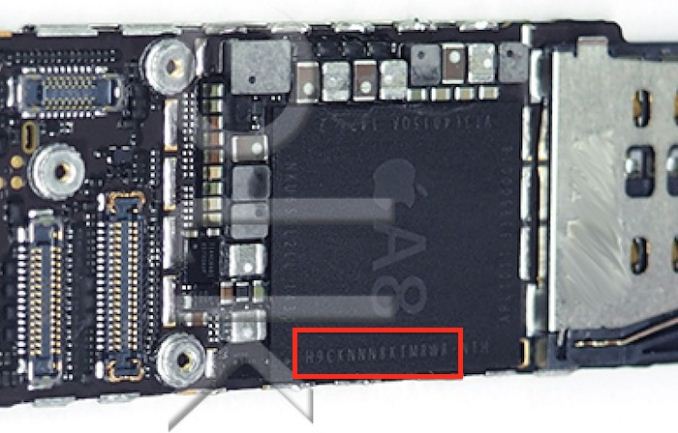
Image Courtesy Macrumors
The good news is that this is going to be the easiest aspect of the iPhone 6 to confirm, since diagnostic apps will be able to query the phone for the RAM amount. So one way or another we should know for sure come September 19th.



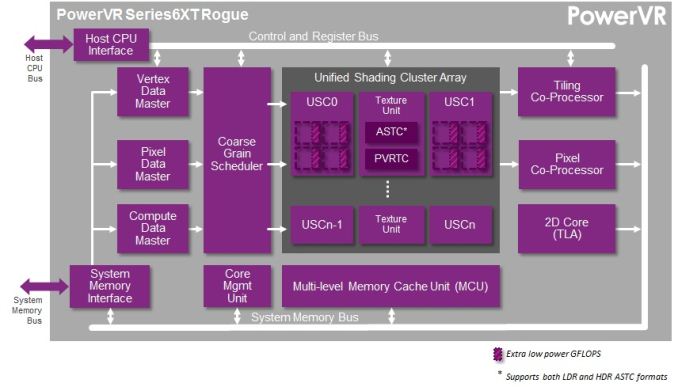
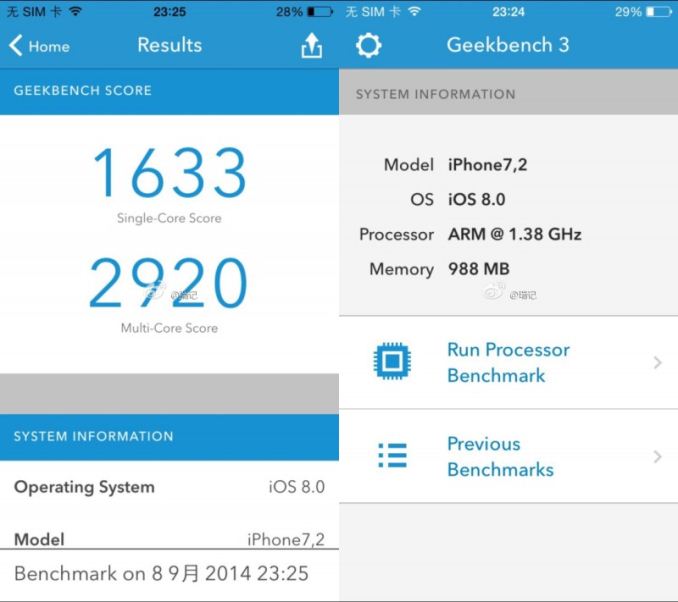
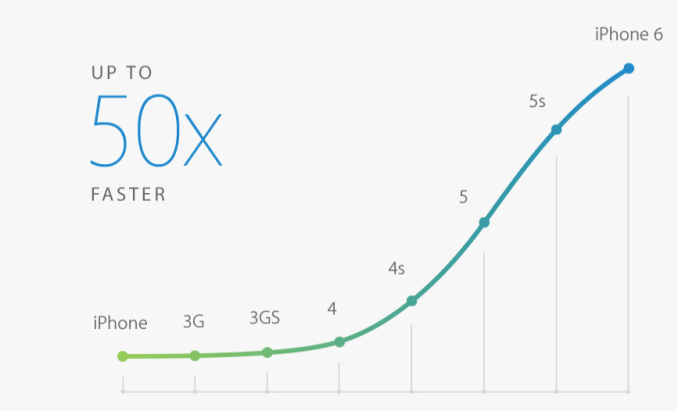








136 Comments
View All Comments
gngl - Saturday, September 13, 2014 - link
"DRAM needs constant power to refresh every cell."Constant (well, more like periodic) but <10% of the total energy budget, isn't it?
Flunk - Friday, September 12, 2014 - link
No, I don't think that's it. I think Apple believes they can get away with it and as long as they can get away with it they will. Every cent of money saved increases their bottom line and as a corporation that's their job, maximize shareholder value.McD - Saturday, September 13, 2014 - link
Kind of. They will get away with it for as long as they can - to benefit the consumer. When they increase the memory footprint the apps are optimised to take advantage of the extra memory which is the death knell for the older devices with smaller footprints. Maintaining the smaller footprint protracts obsolescence and extend the product's useful life.Unlike its competitors, Apple used the transition to mobile to remove many of the poor habits adopted by PC products including poor resource management symptomatic of unfettered multi-tasking; on iOS extra memory does present an automatic benefit to the consumer. The previous wisdom of more RAM = faster no longer applies.
Apples gated approach to RAM increases benefits the consumer but it is time to lose that iPhone4.
techchief - Sunday, September 14, 2014 - link
Nothing Apple ever does is for the benefit of the consumer. They are the anti-consumer company. Apple was found guilty of collusion with e-book publishers and was the chief leader for collusion against engineer poaching which kept salaries down for their engineering stuff. Same with NFC. It would have cost them just 10c to have included NFC into the iPhone 5S which also had the Touch ID. As it stands, no iphone out there can use Apple pay but only the brand new one... all for savings of 10c. Apple is the anti-consumer company. They are the greedy company. And if you are a consumer, you wouldn't want any of your dollars going to that kind of a company .mesahusa - Monday, September 15, 2014 - link
apple isnt just going to shove random shit into their phones like other companies do just to see if it works. as you can tell, google wallet has failed miserably despite a ton of flagship phones having nfc. watch the keynote. apple got dozens of AAA companies to adopt it including macys, mcdonalds, whole foods, etc. its not easy to convince huge companies like those to buy millions of nfc detectors for their stores and its even more work to get the banks to do it. the way apple's nfc works is way different than android's. it doesnt just imprint your card # and security code onto the machine. it generates a random code that goes through many security steps so that you dont have to worry about cancelling all of your cards when you leave your phone at a local diner. nfc, along with just about any other feature requires a backbone to support it. companies had no incentive to support it, because google didnt give them one. now android phones are just gonna dickride on the support apple has set up. so enjoy it, not bitch about it.darwiniandude - Tuesday, September 16, 2014 - link
What if they're keeping 1GB as the ceiling as it is 'enough' to ensure developers don't simply code and test for the new devices only.HisDivineOrder - Wednesday, September 10, 2014 - link
To have a bullet for another release next year. How are they going to convince you that upcoming apps require you to buy a whole new phone/tablet if they don't have a hard limit that basically obsoletes your current device?If they gave you 4GB ram right away, then why would you go and buy another iPhone next year after all? Already, too many people are sitting out entire cycles and Apple is starting to see declines in the tablet space. The phone space could follow if they don't keep you wanting to upgrade...
Montrey - Tuesday, September 16, 2014 - link
Will 2GB mean faster Facebook? Probably not for most users, no more than a 13MP camera necessarily makes better looking pictures than an 8MP camera. My Galaxy S4 has bigger numbers than my wife's iPhone 5 in almost every respect, but apart from screen size, it falls flat in user experience.nsiltane - Wednesday, September 10, 2014 - link
Ram might be on package but it's definitely not on the SOC die itself.solarisking - Wednesday, September 10, 2014 - link
After looking it up, I see the RAM for the A7/A8 is not on the SOC itself, but package-on-package (PoP), stacked vertically, for the iPhone. For the iPad it's not PoP but on-board. This would make it even easier to add RAM. I'm guessing they will for the iPhone 6S in a year.